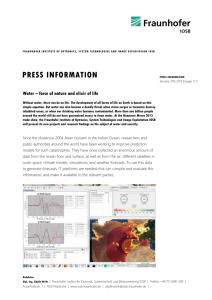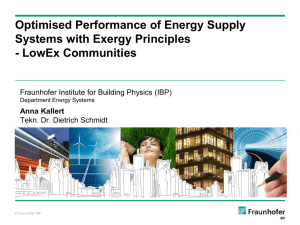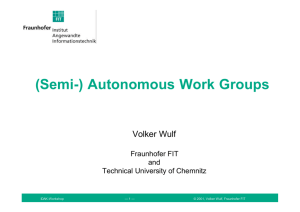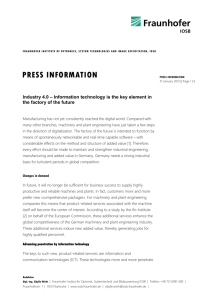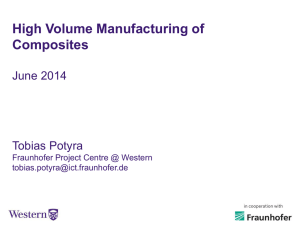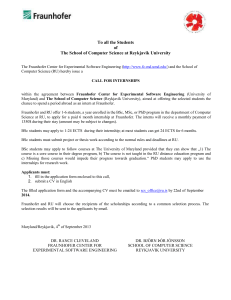Dr. Forrest Shull - Systems Engineering Research Center
advertisement
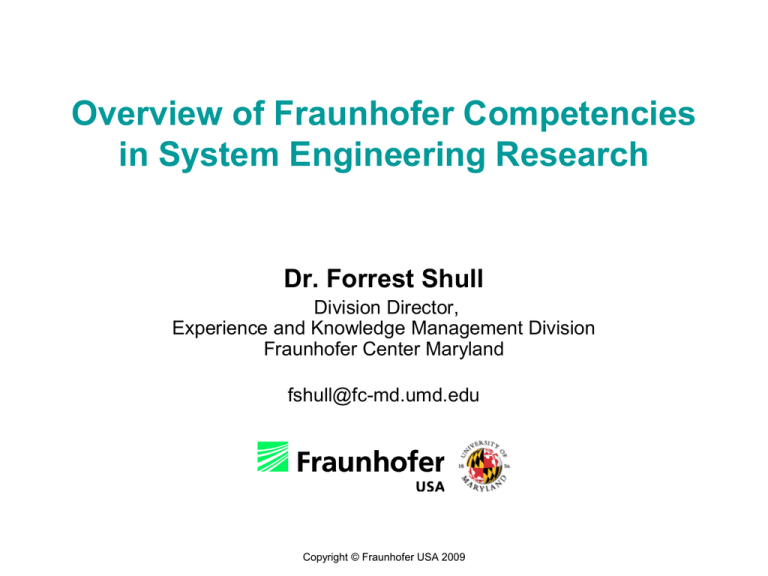
Overview of Fraunhofer Competencies in System Engineering Research Dr. Forrest Shull Division Director, Experience and Knowledge Management Division Fraunhofer Center Maryland fshull@fc-md.umd.edu Copyright © Fraunhofer USA 2009 Fraunhofer Center Maryland (FC-MD) Center for Experimental Software Engineering • A not-for-profit applied research & technology transfer organization • Founded in 1997 by Dr. Victor Basili and Dr. Marv Zelkowitz • Affiliated with University of Maryland at College Park • One of six Fraunhofer USA Centers • Vision: – Apply a scientific/engineering method to system and software engineering – Utilize past results to guide development choices – Use organizational learning as the key to improvement Copyright © Fraunhofer USA 2009 October 2009 Fraunhofer Center Maryland (FC-MD) Our Staff • ~25 technical personnel – Scientists • Many with significant track records of research and tech transfer – Applied Technology Engineers • Many with 20+ years of experience in government and commercial organizations – Part-time university faculty (associate and adjunct professors) • Maintaining tight connection with local university departments – Interns • University students who desire experience on cutting-edge problems as part of their studies Copyright © Fraunhofer USA 2009 October 2009 Fraunhofer Center Maryland (FC-MD) Partners & Customers Mission: Advance real-world practices via empirically validated research into system- and softwareengineering technologies and processes We bridge research and application, working with: • • • • • • Government organizations (DoD, NASA, …) Large industrial companies (Boeing, Motorola, …) Small/medium-sized organizations (KeyMind,…) National labs (Los Alamos Labs, ….) Universities and research centers (CMU, USC, MIT, …) …and others (SEI, MITRE, JHU/APL, ...) Copyright © Fraunhofer USA 2009 October 2009 Example of Competencies: SERC EM Task • Goals: – Compare SEPAT effectiveness measures with DAPS assessment methodology to determine gaps and coverage – Provide constructive feedback to both model owners as appropriate. – Determine the significance of SEPAT effectiveness measures w/r/t SE EM Framework Area Interpretation DAPS DAPS Topic Covered SADB negative findings. Section • Example research methods: Use very experienced SMEs to • • • Identify and select key topic areas Analyze both reference docs and create comparison map Request SADB findings on key queries and map to SEPAT Copyright © Fraunhofer USA 2009 1 Concurrent definition of system requirements and solutions 1.1 Understanding of stakeholder needs: capabilities, operational concept, key performance parameters, enterprise fit (legacy) 1. At Milestone A, have the KPPs been identified in clear, Understandable, 1. comprehensive, concise terms that are understandable comprehensive requirements 1 to the users of the system? 1.3.2 KPPs and KSAs 1. Has a CONOPS been developed showing that the 1. system can be operated to handle both nominal and 2 off-nominal workloads, and to meet response time feasible workload demonstrated at CONOPS; are scenarios quantified 1.1 1.2 1.3.1 CONOPS Analysis of Alternatives Reasonableness, Stability, and Testability 1. Has the ability of the system to meet mission 1. effectiveness goals been verified through the use of 3 modeling and simulation? verification of mission goals 1.2.1 Validity and Currency (1.2 Analysis of Alternatives) Reasonableness, Stability, and Testability Modeling and Simulation Tools requirements? 1.1 1.3.1 4.4.2 CONOPS October 2009 Example of Competencies: SERC EM Task • Results: – The SEPAT has ‘rolled up’ many subtopics into fewer effectiveness areas; DAPS is more broad and more specific – Several key concepts found in SEPAT seem to be absent or used in a different manner in the DAPS context, such as • • • • • Negotiating roles & responsibilities Nominal/off-nominal Stakeholder concurrence/acceptance Feasibility evidence Timeboxing – DAPS is very DoD-process oriented; as a result, its guidance on what the program should do when is more specific, e.g., each section addresses Milestones A, B, and C as appropriate. Copyright © Fraunhofer USA 2009 October 2009 Example of Competencies: SERC MPT Task • Goals: – Explore MPTs & gaps w/r/t agility and responsiveness to change, in context – Conceptualize agile challenges along with: • Themes – Important components of a solution for each challenge • Elements – Key activities that must be completed to achieve each theme • MPTs – Existing sets of methods, processes, and tools that together provide an actionable way of achieving an element. • Example research methods: – Conducted survey of organizations with relevant experience – Qualitative analysis of responses to identify concrete suggestions, contexts where appropriate, and areas still missing concrete MPTs • Results: The bridge maps we are creating provide a way of encapsulating practical experience as to MPTs that can be recommended & further research to be done. Copyright © Fraunhofer USA 2009 October 2009 Example of Competencies: SERC MPT Task Results (cont.): • Worked with sponsor to understand context • 100+ surveys analyzed • Initial ‘bridge diagrams’ allow recommending initial MPTs for context • Gap analysis allows discovery of areas requiring research to develop new MPTs Copyright © Fraunhofer USA 2009 October 2009 Example of Competencies: DOD Best Practices Clearinghouse • Goals: – Provide the system engineering workforce with recommendations about applicable MPTs, based on experiential information from practice – Communicate the effectiveness of SE MPTs based on cost, schedule, and quality impact on real projects – – Example research methods: – Exploring use of multiple methods (interviews, surveys, questionnaires) to elicit experiential information – Application of qualitative and quantitative reasoning to aggregate information about practice’s costs and benefits – Developing information tagging by context, keywords, ontologies Results: – A published website and growing support team of contributors and SMEs (e.g. from DAU campuses, AFIT) – ~10K page views / month Copyright © Fraunhofer USA 2009 October 2009 Example of Competencies: DOD Best Practices Clearinghouse Overview of building content Practice Maturity Name: Practice X Σ • Clearinghouse content starts with practices recommended by government •Use it toand … industry experts •Practice X has been successfully applied … Σ •For more information click on the following links: • •… BPCh recommendations must be based on evidence from real programs: (Bronze) (Silver) (Gold) – From publications – From interviews & feedback with users – From vetted expert guidebooks & standards Evidence 1 Evidence 2 Copyright © Fraunhofer USASource 2009 Source Context Context Results Results Evidence 3 Evidence 4 Source Context Results Source Context Results October 2009 Example of Competencies: Software Safety Metrics • Goals: – Provide some quantifiable evidence of potential risk w/r/t software safety and whether projects are addressing that risk – Approach is applicable to other key properties of the system early in the lifecycle • Example research methods: – Developing models that isolate specific deficiencies, codify the risks, and offer possible responses • • Identify data in the artifacts available to address the problem Identify gaps in the data and propose responses to those gaps – Evaluate artifacts produced by the process over time • • • E.g. Evaluating software-related hazard reports from multiple Constellation elements (Orion, Ares US, J-2X) Monitor areas of risk over time Do not depend on designs or code alone to evaluate safety Copyright © Fraunhofer USA 2009 October 2009 Example of Competencies: Software Safety Metrics • Results: – Modeling hazards: • Models of deficiencies in software risk causes, e.g. lack of specificity • Currently extending model to characterize software controls and verifications – Modeling the evolution of software-related hazards to: • Provide snapshots of software risk areas • Identify highest risk elements, systems and subsystems • Find mission drivers with the highest risk related to software – Developing metric templates for SR&QA personnel and vendors – Analysis of hazard reports is applicable and relevant to NASA projects with a similar hazard analysis and reporting structure – Future work will expand this approach to artifacts other than hazard reports Copyright © Fraunhofer USA 2009 October 2009 Example of Competencies: Improving Sys & SW Tech Reviews • Goals: – Fundamental research aimed at applying a proven system engineering practice to contemporary constraints and problems – Work with many NASA missions aimed at integration of inspection best practices with program execution activities – Further deployment to reach the NASA System Engineering workforce • Example research methods: – Quantitative statistical testing based on 2500+ data points – Tailoring of method to project environments, handling software- and system-level technical documents – Encoding research results into tool support for use by NASA teams • Results: – Concrete, practical information formulated and infused with teams – Tool support developed and tested – Inclusion in NASA’s safety curriculum Copyright © Fraunhofer USA 2009 October 2009 Example of Competencies: Improving Sys & SW Tech Reviews SSC: LH Barge Ladder Logic IV&V: James Webb Space Telescope ARC: Simulink models for smallsat Wallops: SIPS Core Slaving Computation Process JSC: LIDS Copyright © Fraunhofer USA 2009 GSFC & MSFC: NPR 7150.2 procedural reqts for software engineering. October 2009 Example of Competencies: Model-based V&V of med devices • Goals: – Demonstrate feasibility & cost effectiveness of an advanced MPT (model-based checking) for complex, safety-critical systems • Example Research Methods: – Work with customer on real system to address scalability concerns – Ensure integration with industry standard modeling tools • Results: – This practice currently being piloted as part of the Generic Infusion Pump (GIP) project – Models of a GIP have been constructed – Safety requirements created from hazards analysis – Safety requirements converted into monitor models (26 done so far) – Verified against GIP model Copyright © Fraunhofer USA 2009 October 2009 Example of Competencies: Model-based V&V of med devices When is the requirement valid? Ideal output according to req. Is this always value 1 for all simulation time instants? Obtained from model under verification Copyright © Fraunhofer USA 2009 Are ideal and expected equal? October 2009 Summary • Proven results in a variety of contexts – Including safety- and mission-criticality • …and for a number of sponsors. • Effective at working both with researchers and engineers – And communicating results that improve work in progress • Central theme of results: Learning from analysis, measurement, and experience Copyright © Fraunhofer USA 2009 October 2009 For More Info… • Contact info: Forrest Shull fshull@fc-md.umd.edu (240) 487-2904 Copyright © Fraunhofer USA 2009 October 2009 For More Info… Key pubs (excerpts) • • • • • SERC UARC: – Pennotti, M., Turner, R., and Shull, F., “Evaluating the Effectiveness of Systems and Software Engineering Methods, Processes and Tools for Use in Defense Programs,” Proc. IEEE International Systems Conference, pp. 319-322. Vancouver, BC, Canada, March 23-26, 2009. DOD Best Practices Clearinghouse: – https://bpch.dau.mil – Feldmann, R., Shull, F., and Shaw, M., “Decision Support for Best Practices: Lessons Learned on Bridging the Gap between Research and Applied Practice,” Acquisition Review Journal, vol. 14, no. 1, pp. 235-247, February 2007. NASA Safety Metrics for Constellation: – Contact Dr. Victor Basili, basili@fc-md.umd.edu NASA Software & System Technical Reviews: – Denger, C., and Shull, F., “A Practical Approach for Quality-Driven Inspections,” IEEE Software, vol. 24, no. 2, pp. 79-86, March/April 2007. FDA Model-Based V&V: – Penn Engineering Technical Report, http://repository.upenn.edu/cis_reports/893/ Copyright © Fraunhofer USA 2009 October 2009


